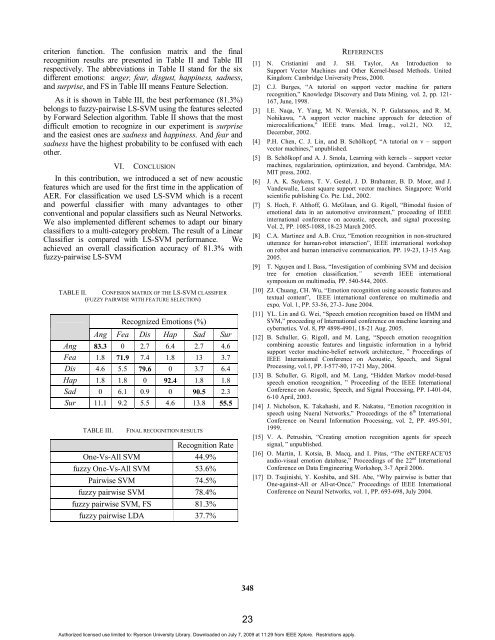Signal Analysis Research (SAR) Group - RNet - Ryerson University
Signal Analysis Research (SAR) Group - RNet - Ryerson University
Signal Analysis Research (SAR) Group - RNet - Ryerson University
Create successful ePaper yourself
Turn your PDF publications into a flip-book with our unique Google optimized e-Paper software.
criterion function. The confusion matrix and the final<br />
recognition results are presented in Table II and Table III<br />
respectively. The abbreviations in Table II stand for the six<br />
different emotions: anger, fear, disgust, happiness, sadness,<br />
and surprise, and FS in Table III means Feature Selection.<br />
As it is shown in Table III, the best performance (81.3%)<br />
belongs to fuzzy-pairwise LS-SVM using the features selected<br />
by Forward Selection algorithm. Table II shows that the most<br />
difficult emotion to recognize in our experiment is surprise<br />
and the easiest ones are sadness and happiness. And fear and<br />
sadness have the highest probability to be confused with each<br />
other.<br />
VI. CONCLUSION<br />
In this contribution, we introduced a set of new acoustic<br />
features which are used for the first time in the application of<br />
AER. For classification we used LS-SVM which is a recent<br />
and powerful classifier with many advantages to other<br />
conventional and popular classifiers such as Neural Networks.<br />
We also implemented different schemes to adapt our binary<br />
classifiers to a multi-category problem. The result of a Linear<br />
Classifier is compared with LS-SVM performance. We<br />
achieved an overall classification accuracy of 81.3% with<br />
fuzzy-pairwise LS-SVM<br />
TABLE II. CONFISION MATRIX OF THE LS-SVM CLASSIFIER<br />
(FUZZY PAIRWISE WITH FEATURE SELECTION)<br />
Recognized Emotions (%)<br />
Ang Fea Dis Hap Sad Sur<br />
Ang 83.3 0 2.7 6.4 2.7 4.6<br />
Fea 1.8 71.9 7.4 1.8 13 3.7<br />
Dis 4.6 5.5 79.6 0 3.7 6.4<br />
Hap 1.8 1.8 0 92.4 1.8 1.8<br />
Sad 0 6.1 0.9 0 90.5 2.3<br />
Sur 11.1 9.2 5.5 4.6 13.8 55.5<br />
TABLE III. FINAL RECOGNITION RESULTS<br />
Recognition Rate<br />
One-Vs-All SVM 44.9%<br />
fuzzy One-Vs-All SVM 53.6%<br />
Pairwise SVM 74.5%<br />
fuzzy pairwise SVM 78.4%<br />
fuzzy pairwise SVM, FS 81.3%<br />
fuzzy pairwise LDA 37.7%<br />
348<br />
REFERENCES<br />
[1] N. Cristianini and J. SH. Taylor, An Introduction to<br />
Support Vector Machines and Other Kernel-based Methods. United<br />
Kingdom: Cambridge <strong>University</strong> Press, 2000.<br />
[2] C.J. Burges, “A tutorial on support vector machine for pattern<br />
recognition,” Knowledge Discovery and Data Mining, vol. 2, pp. 121-<br />
167, June, 1998.<br />
[3] I.E. Naqa, Y. Yang, M. N. Wernick, N. P. Galatsanos, and R. M.<br />
Nohikawa, “A support vector machine approach for detection of<br />
microcalifications,” IEEE trans. Med. Imag., vol.21, NO. 12,<br />
December, 2002.<br />
[4] P.H. Chen, C. J. Lin, and B. Schölkopf, “A tutorial on ν – support<br />
vector machines,” unpublished.<br />
[5] B. Schölkopf and A. J. Smola, Learning with kernels – support vector<br />
machines, regularization, optimization, and beyond. Cambridge, MA:<br />
MIT press, 2002.<br />
[6] J. A. K. Suykens, T. V. Gestel, J. D. Brabanter, B. D. Moor, and J.<br />
Vandewalle, Least square support vector machines. Singapore: World<br />
scientific publishing Co. Pte. Ltd., 2002.<br />
[7] S. Hoch, F. Althoff, G. McGlaun, and G. Rigoll, “Bimodal fusion of<br />
emotional data in an automotive environment,” proceeding of IEEE<br />
international conference on acoustic, speech, and signal processing.<br />
Vol. 2, PP. 1085-1088, 18-23 March 2005.<br />
[8] C.A. Martinez and A.B. Cruz, “Emotion recognition in non-structured<br />
utterance for human-robot interaction”, IEEE international workshop<br />
on robot and human interactive communication, PP. 19-23, 13-15 Aug.<br />
2005.<br />
[9] T. Nguyen and I. Bass, “Investigation of combining SVM and decision<br />
tree for emotion classification,” seventh IEEE international<br />
symposium on multimedia, PP. 540-544, 2005.<br />
[10] ZJ. Chuang, CH. Wu, “Emotion recognition using acoustic features and<br />
textual content”, IEEE international conference on multimedia and<br />
expo, Vol. 1, PP. 53-56, 27-3- June 2004.<br />
[11] YL. Lin and G. Wei, “Speech emotion recognition based on HMM and<br />
SVM,” proceeding of International conference on machine learning and<br />
cybernetics, Vol. 8, PP 4898-4901, 18-21 Aug. 2005.<br />
[12] B. Schuller, G. Rigoll, and M. Lang, “Speech emotion recognition<br />
combining acoustic features and linguistic information in a hybrid<br />
support vector machine-belief network architecture, ” Proceedings of<br />
IEEE International Conference on Acoustic, Speech, and <strong>Signal</strong><br />
Processing, vol.1, PP. I-577-80, 17-21 May, 2004.<br />
[13] B. Schuller, G. Rigoll, and M. Lang, “Hidden Markov model-based<br />
speech emotion recognition, ” Proceeding of the IEEE International<br />
Conference on Acoustic, Speech, and <strong>Signal</strong> Processing, PP. I-401-04,<br />
6-10 April, 2003.<br />
[14] J. Nicholson, K. Takahashi, and R. Nakatsu, “Emotion recognition in<br />
speech using Nueral Networks,” Proceedings of the 6 th International<br />
Conference on Neural Information Processing, vol. 2, PP. 495-501,<br />
1999.<br />
[15] V. A. Petrushin, “Creating emotion recognition agents for speech<br />
signal, ” unpublished.<br />
[16] O. Martin, I. Kotsia, B. Macq, and I. Pitas, “The eNTERFACE’05<br />
audio-visual emotion database,” Proceedings of the 22 nd International<br />
Conference on Data Emgineering Workshop, 3-7 April 2006.<br />
[17] D. Tsujinishi, Y. Koshiba, and SH. Abe, “Why pairwise is better that<br />
One-against-All or All-at-Once,” Proceedings of IEEE International<br />
Conference on Neural Networks, vol. 1, PP. 693-698, July 2004.<br />
Authorized licensed use limited to: <strong>Ryerson</strong> <strong>University</strong> Library. Downloaded on July 7, 2009 at 11:29 from IEEE Xplore. Restrictions apply.<br />
23


